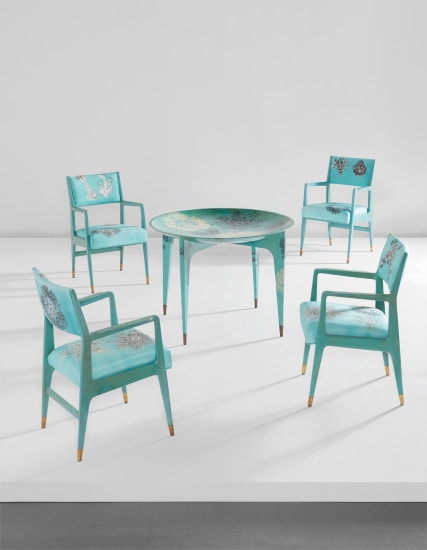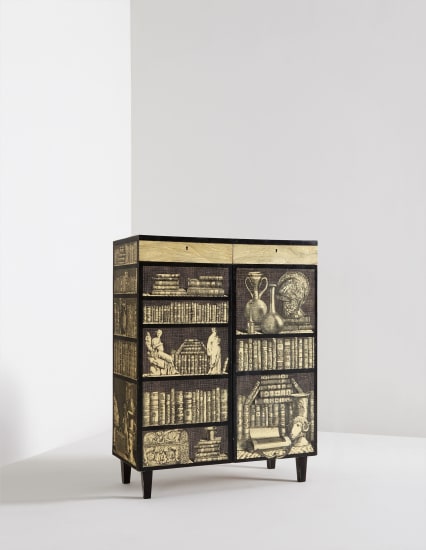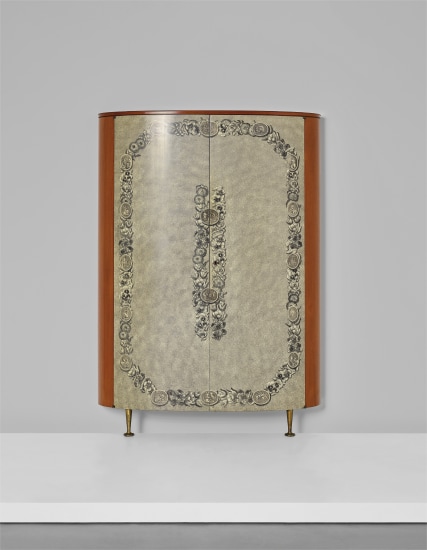Design from the Collection of Trudie Styler & Sting Piero Fornasetti Follow "La Stanza Metafisica" (Metaphysical Room) 1958 Lithographic transfer-printed wood, painted wood, brass hinges. Each panel: 98 1/4 x 19 3/4 x 1 1/4 in. (249.6 x 50.2 x 3.2 cm) Last panel signed Fornasetti 58 .
Provenance Themes & Variations, London, acquired directly from the artist Christie's, New York, "Important 20th Century Decorative Arts including Arts and Crafts, Art Nouveau, Art Deco and Post-War Designs," December 17, 1983, lot 393 Private collection Christie's, Los Angeles, "Important Design: The Life of Piero Fornasetti " May 16, 1998, lot 203 Acquired from the above Sotheby's, New York, "Important Postwar and Contemporary Design," November 16, 2007, lot 44 Acquired from the above by the present owner Exhibited "Exhibition of Fornasetti's Decorative Objects," The Tea Centre, London, September 17-October 3, 1958 Landesgewerbemuseum, Karlsruhe, January 31-March 4, 1962 Literature "Notiziaro," Domus , no. 385, December 1961, illustrated, n.p. Casa Vogue , no. 88, November 1978, illustrated on the cover Patrick Mauriès, Fornasetti Designer of Dreams , London, 1991, illustrated pp. 126-29 Barnaba Fornasetti, ed., Fornasetti: The Complete Universe , New York, 2010, illustrated pp. 420, 435-38 Video Piero Fornasetti’s Thirty-Two Panels Manifest “La Stanza Metafisica”, The Metaphysical Space Piero Fornasetti was fascinated with screens—he referred to them as his favorite “children”—and approached them as theatrical curtains that acted as modular pieces of furniture. This is nowhere demonstrated more intensely than in “La Stanza Metafisica”. Fornasetti designed the 32 panels, decorated with a surrealist composition of stairways, passageways and ladders, as a space for meditation that could travel with the user. Catalogue Essay “[The Metaphysical Room] was conceived…as a place dedicated to meditation, where one or more people may stay and gather their thoughts, whether creative or religious or of some other kind. Modern man is losing this important habit…After having noted the room’s power of suggestion, I thought it could also live another life: that is, the decoration of the walls could serve as the background for the decoration of rooms of various use. The screen of thirty-two panels that constitutes the room could assume larger or smaller dimensions by adding or removing panels, and could be adapted to the walls of a given room…It can cover the walls entirely…it can be used in the dining room rather than in the bedroom. On a given day it would be used to create a setting within a setting—for example, in a large living room it could be used to close off the space for conversation near the fireplace…or for a dinner or a party…A person could change residence and there would be no need for him to lose the background of the settings in which he accustomed to live. He could take his walls with him, as they are also washable and easily transportable.” -Piero Fornasetti --- Piero Fornasetti was a phenomenally talented and prolific painter and illustrator, but his talents soared far beyond two-dimensional artwork. He was fascinated by the organization of interior spaces and the screen, at once a blank canvas, a theatrical curtain, and a permutable and modular piece of furniture, was the perfect springboard for Fornasetti’s ideas. He referred to screens as his favorite “children” and traced the history of the screen, noting interesting details such as the fact that “In Europe they first appear in the early Middle Ages, and were made of all sorts of materials, even wicker; they were used to separate the beds of the members of a noble entourage when they had to sleep in a single room. They came to be called para vento in Italian because of their use in churches to protect the officiants from drafts.” Fornasetti was particularly interested in Japanese screens and was a connoisseur of the various forms, styles, and techniques. Much influenced by Japanese design and architecture, he revered In Praise of Shadows by Junichiro Tanizaki, a 1933 treatise on traditional Japanese aesthetics still studied by architects today. Fornasetti synthesized all of these ideas in his famous “Stanza Metafisica” (Metaphysical Room). Composed of thirty-two panel
Design from the Collection of Trudie Styler & Sting Piero Fornasetti Follow "La Stanza Metafisica" (Metaphysical Room) 1958 Lithographic transfer-printed wood, painted wood, brass hinges. Each panel: 98 1/4 x 19 3/4 x 1 1/4 in. (249.6 x 50.2 x 3.2 cm) Last panel signed Fornasetti 58 .
Provenance Themes & Variations, London, acquired directly from the artist Christie's, New York, "Important 20th Century Decorative Arts including Arts and Crafts, Art Nouveau, Art Deco and Post-War Designs," December 17, 1983, lot 393 Private collection Christie's, Los Angeles, "Important Design: The Life of Piero Fornasetti " May 16, 1998, lot 203 Acquired from the above Sotheby's, New York, "Important Postwar and Contemporary Design," November 16, 2007, lot 44 Acquired from the above by the present owner Exhibited "Exhibition of Fornasetti's Decorative Objects," The Tea Centre, London, September 17-October 3, 1958 Landesgewerbemuseum, Karlsruhe, January 31-March 4, 1962 Literature "Notiziaro," Domus , no. 385, December 1961, illustrated, n.p. Casa Vogue , no. 88, November 1978, illustrated on the cover Patrick Mauriès, Fornasetti Designer of Dreams , London, 1991, illustrated pp. 126-29 Barnaba Fornasetti, ed., Fornasetti: The Complete Universe , New York, 2010, illustrated pp. 420, 435-38 Video Piero Fornasetti’s Thirty-Two Panels Manifest “La Stanza Metafisica”, The Metaphysical Space Piero Fornasetti was fascinated with screens—he referred to them as his favorite “children”—and approached them as theatrical curtains that acted as modular pieces of furniture. This is nowhere demonstrated more intensely than in “La Stanza Metafisica”. Fornasetti designed the 32 panels, decorated with a surrealist composition of stairways, passageways and ladders, as a space for meditation that could travel with the user. Catalogue Essay “[The Metaphysical Room] was conceived…as a place dedicated to meditation, where one or more people may stay and gather their thoughts, whether creative or religious or of some other kind. Modern man is losing this important habit…After having noted the room’s power of suggestion, I thought it could also live another life: that is, the decoration of the walls could serve as the background for the decoration of rooms of various use. The screen of thirty-two panels that constitutes the room could assume larger or smaller dimensions by adding or removing panels, and could be adapted to the walls of a given room…It can cover the walls entirely…it can be used in the dining room rather than in the bedroom. On a given day it would be used to create a setting within a setting—for example, in a large living room it could be used to close off the space for conversation near the fireplace…or for a dinner or a party…A person could change residence and there would be no need for him to lose the background of the settings in which he accustomed to live. He could take his walls with him, as they are also washable and easily transportable.” -Piero Fornasetti --- Piero Fornasetti was a phenomenally talented and prolific painter and illustrator, but his talents soared far beyond two-dimensional artwork. He was fascinated by the organization of interior spaces and the screen, at once a blank canvas, a theatrical curtain, and a permutable and modular piece of furniture, was the perfect springboard for Fornasetti’s ideas. He referred to screens as his favorite “children” and traced the history of the screen, noting interesting details such as the fact that “In Europe they first appear in the early Middle Ages, and were made of all sorts of materials, even wicker; they were used to separate the beds of the members of a noble entourage when they had to sleep in a single room. They came to be called para vento in Italian because of their use in churches to protect the officiants from drafts.” Fornasetti was particularly interested in Japanese screens and was a connoisseur of the various forms, styles, and techniques. Much influenced by Japanese design and architecture, he revered In Praise of Shadows by Junichiro Tanizaki, a 1933 treatise on traditional Japanese aesthetics still studied by architects today. Fornasetti synthesized all of these ideas in his famous “Stanza Metafisica” (Metaphysical Room). Composed of thirty-two panel









.jpg)



Testen Sie LotSearch und seine Premium-Features 7 Tage - ohne Kosten!
Lassen Sie sich automatisch über neue Objekte in kommenden Auktionen benachrichtigen.
Suchauftrag anlegen